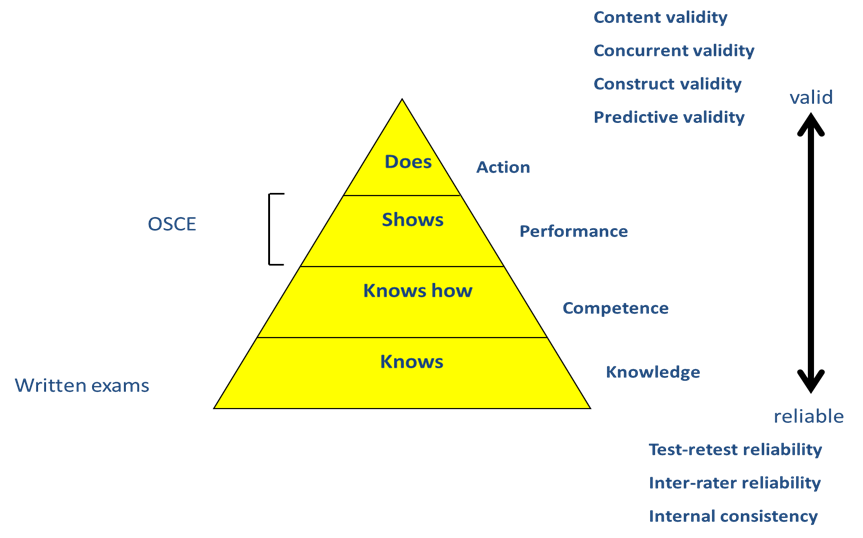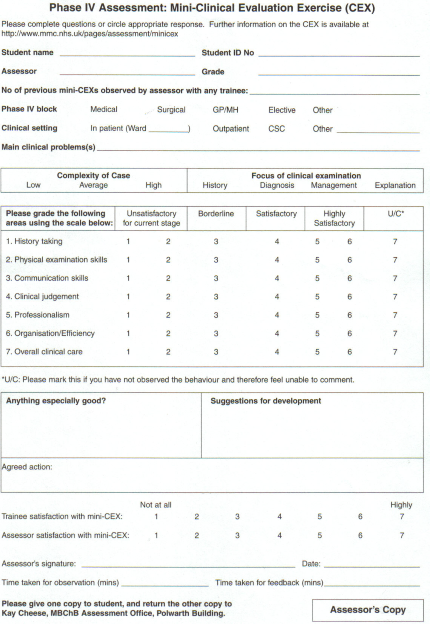Workplace Based Assessments (WBA) in the MBChB and PA Programmes
This section contains more in-depth material should you wish to learn more about workplace based assessment
Contents
- Overview of senior MBChB and PA assessments
- Theoretical basis of practical assessments
- Workplace based assessments
- Importance of feedback
- Feedback examples
- Strengths and limitations
- Conclusion
Overview of Assessments
Year 5 students undertake both:
- Formative assessments in each block. These include mini-Clinical Examinations (mini-CEXs) and Directly Observed Procedural skills (DOPS).
- Summative assessments. These consist of summative mini-CEXs, the end of block assessment with the students' clinical supervisors, and the exit clinical degree summative examination at the end of the year.
Students in year 4 and in the physician assistant programme have formative end of block assessment as well as formative and summative written and OSCE examinations. MiniCEX and DOPs are also used summatively in the PA programme.
Theoretical Basis of Practical Assessments
Work based assessments are defined as:
"The assessment of working practices based on what doctors actually do in the workplace, and is predominantly carried out in the workplace itself" (PMETB, 2007)
During undergraduate medical training, work based methods of assessment aim to evaluate the students' performance in their normal practice. By observing a student's integration of knowledge with their actions WBAs provide a more valid picture of a student's higher understanding of a clinical topic.
Miller's pyramid illustrates the levels of learning. It also provides guidance in judging the validity and reliability between written exams testing factual recall and OSCEs testing competence. The aim of formative and summative examinations is to provide results which closely match what students would actually do in a situation and how they would do it.

Workplace Based Assessments
The GMC review resulted in the introduction of end of year Objective Structured Clinical Examinations (OSCEs) which are standardised in content and marking criteria across all examination sites for all students.
Mini-Clinical Examinations and Direct Observation of Procedural Skills were also introduced to ensure that a component of the Year 5 summative examinations occurred continuously throughout the year and are used formatively in year 4. In the PA programme WBAs are used both formatively and summatively.
Mini-Clinical Examinations (Mini-CEXs)
- Mini-CEXs put on an emphasis of assessment of clinical examination skills. It is an observed clinical encounter which provides a "snapshot" of a trainee-patient interaction.
- They provide the educational value and validity of workplace based assessments.
- Mini-CEXs are used in all clinical blocks in the final year as formative and summative examinations.
- The summative component contributes 20% of the Year 5 final mark.
- Students are required to complete a minimum number of mini-CEX assessments per clinical block and are responsible for organising a date and time with a senior registrar or consultant to complete these.
- The examination can occur in a range of settings: community-based, out-patient, in-patient or acute care setting.
How should it work?
- Observation: no longer than 15-20 minutes.
- Immediate feedback: no longer than 5 minutes.
- Selection of a willing and appropriate patient.
- Direct the student to take a relevant history and perform a focused examination. Findings may lead to discussing investigations and diagnosis.
- Focus of clinical encounter: assessment of the trainees' examination skills and ability to form a provisional diagnosis.
- Complexity of case: Please score the difficulty of the clinical case for the level of a student at this stage of the course.
- Feedback: In order to maximise the educational impact, you and the trainee need to identify agreed strengths, areas for development and an action plan.

Direct Observation of Procedural Skills (DOPS)
DOPS forms aim to assess technical skills including basic diagnostic and interventional procedures. This facilitates feedback and highlights good practice in preparation for the foundation programme.
Supervised by member of staff competent to perform the procedure, including FY trainees, paramedical staff and senior doctors. Examples: venesection, urethral catheterisation, ECG, suturing, moving and handling patients, scrubbing up etc.
| Unsatisfactory | Borderline | Successful performance | Outstanding Performance | |
|---|---|---|---|---|
| Demonstrates understanding of indicators | ||||
| Obtains informed consent | ||||
| Demonstrates appropriate knowledge of procedure and anatomy | ||||
| Technical Ability | ||||
| Demonstrates appropriate & safe handling of equipment | ||||
| Demonstrates asepsis before, during & after procedure if appropriate | ||||
| Completes required communications (written & verbal) appropriately (content, clarity, professional to required personnel including patient and carers) | ||||
| Deals with any unexpected events appropriately (e.g. failure to cannulate vein) | ||||
| Overall professionalism & patient consideration | ||||
| Assessor's comments on student performance | ||||
| Assessor's signature | Date: | |||
Importance of Feedback
The evidence behind formative assessments and immediate feedback:
- Meta-analysis of 12 meta-analyses:
- Feedback is the largest influence on achievement (ES=0.79)
- Feedback alone is effective in 71% of studies
- Observation of a clinical performance enhances learning
- Feedback is critical to learning and has a significant influence on achievement (Hattie 1999; Veloski 2006) - put in link to this paper
Effective Feedback: How to do it?
- Must address three learner questions:
- Where am I going?
- How am I going?
- Where to next?
- Factors affecting the impact of feedback
- Focus
- Trainee
- Technique
- Action plan
- (Hattie & Timperley 2007)
Focus
- Focus on the process: encourages deeper learning and improved performance
- Focus on behaviour: rarely successful
Trainee
- Response to feedback is influenced by:
- Trainee's level of achievement
- Culture
- Perceptions of accuracy
- Perceptions of credibility
- Perceptions of usefulness
Technique
- Huge influence on impact.
- Appropriate location
- Ask learner to give their view early
- Positive feedback as well as areas with room for improvement
- Non judgemental
- Specific
- Right amount vs. a deluge of information
Action Plan
- Leads to change
- "Feedback alone does not cause change, it is the goals that people set in response to feedback"
Feedback Examples
-

Action Plan
Maintain eye contact with patients when palpating the abdomen.
-

Action Plan
Integrate further non-verbal techniques to help communication, such as unfolding your arms and stopping writing.
Strengths and Limitations
Strengths of WBAs
- Sample widely across the curriculum
- Multiple raters
- Used with more reliable assessments to inform high stakes decisions
- Reinforce educational culture where feedback for learning is the norm
- Identify struggling students early
- Can encourage an aspiration to excellence
Limitations of WBA
- Not reliable enough to stand alone
- Low scores = "failure"
- Weaker students least likely to seek feedback
- Time required
- Availability of assessors
- Training of assessors
Tips for Successful Implementation
- Ensure adequate training in giving feedback
- Onus on the student to initiate
- Tutor estimation of time taken i.e. 2 students x 2 mini-CEXs = 2 hours
Conclusion
- Sound educational rationale for mini-CEX
- Thoughtful feedback is crucial